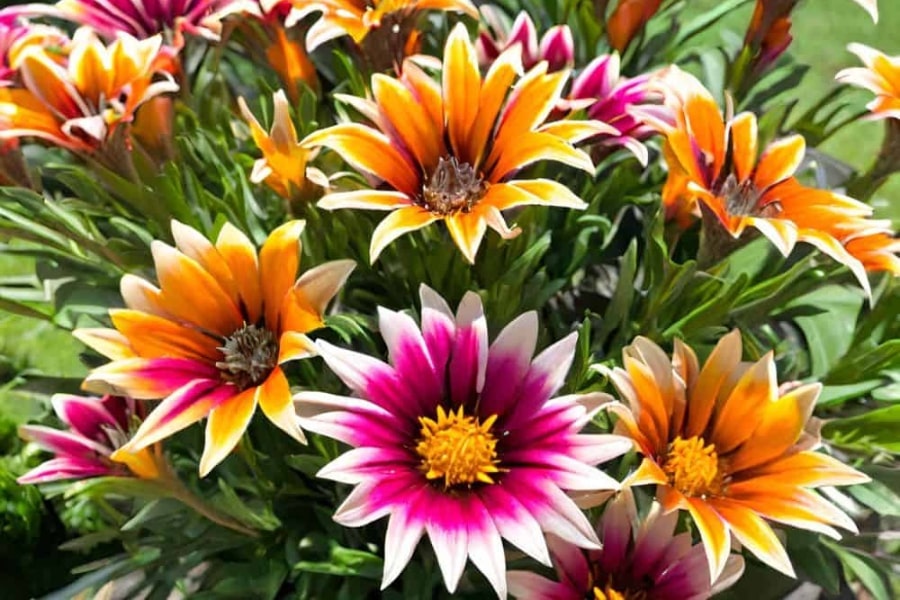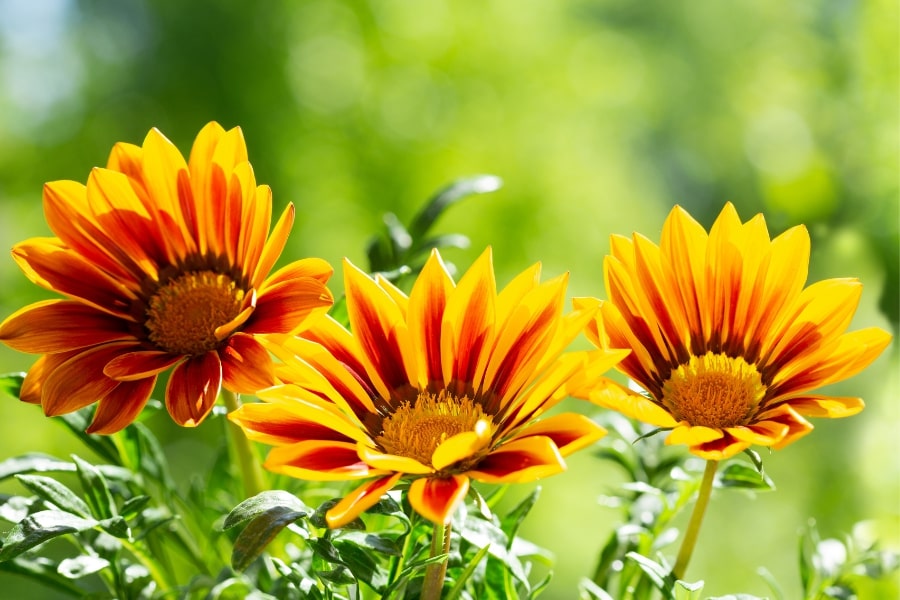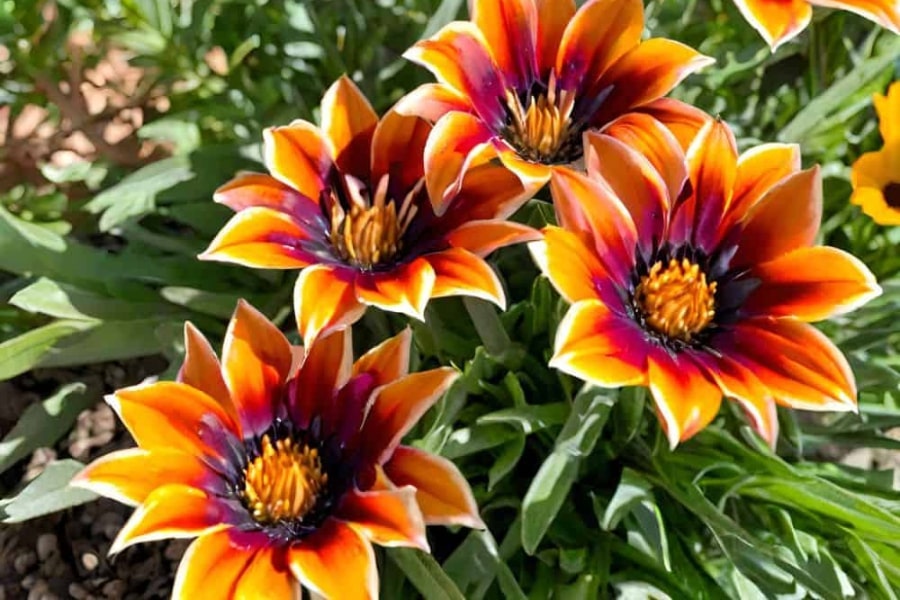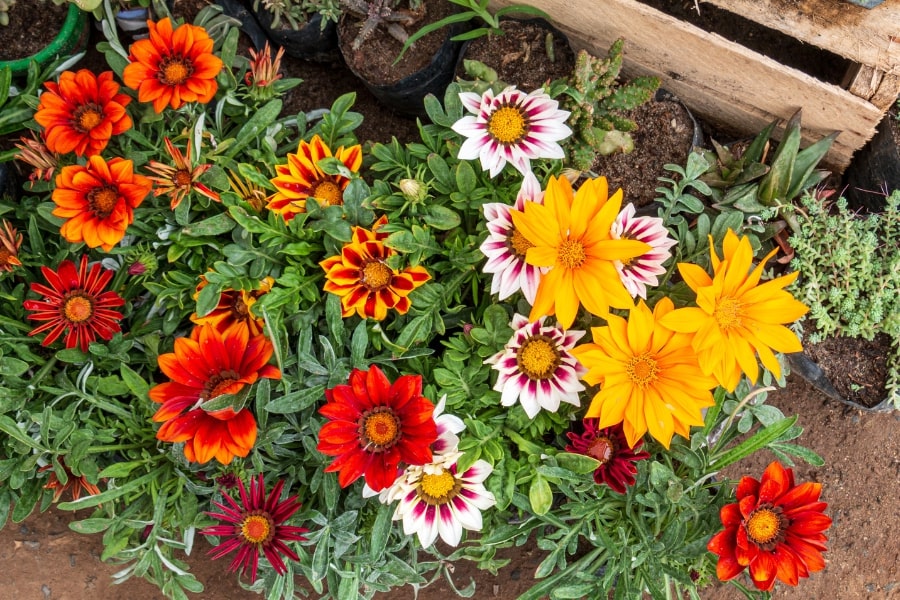Gazania is a dazzling and resilient flowering plant known for its striking daisy-like flowers and low-maintenance nature. Part of the Asteraceae family, this genus of flowering plants originated in South Africa and includes around 16 species. Gazania is derived from the Greek word “gaza,” meaning wealth or treasure, emphasizing the richness of color displayed by its flowers. In the Upstate, there are both Perennial and Annual Gazania.

Our Selection of Gazania
At Martin Garden Center, we are solely dependent on our regional vendors for supplies of Gazania flats, and our stocking is very sporadic. We could apologize but these are the facts that we face, so these are our limitations. So, if you are a Gazania fan, you might want to consider alternative sources or frequent Martin Garden Center so that you get the Gazania you deserve!
Growing and Caring For Gazania
Here are the key aspects of cultivating Gazania successfully:
- Gazanias thrive in full sunlight and prefer well-lit locations. In regions with intense heat, providing some afternoon shade can be beneficial.
- Gazanias are not overly particular about soil conditions and can tolerate a range of soil types. However, they prefer well-drained soil and can withstand poor or sandy soils. Good drainage is crucial to prevent waterlogged conditions, which can lead to root rot.
- Gazanias are drought-tolerant plants that, once established, benefit from regular watering during their initial growth period. Water deeply, but allow the soil to dry out between waterings. Once mature, Gazanias can withstand periods of drought.
- These plants are well-adapted to warm and temperate climates. Gazanias can withstand mild frost but may struggle in areas with prolonged freezing temperatures.
- Deadhead spent flowers regularly to encourage continuous blooming and maintain a tidy appearance. This prevents the plant from directing energy into seed production.
- Gazanias benefit from occasional pruning to control their size and shape. Pruning leggy growth helps maintain a compact and bushy habit.
- Gazanias are not heavy feeders, but providing a balanced, slow-release fertilizer in early spring can promote healthy growth and blooming. Avoid excessive fertilization, as Gazanias generally thrive in lean soils. A well-balanced fertilizer with a low nitrogen content is suitable.
- Occasional pest issues, such as aphids, can occur. Inspect the plants regularly for signs of pests and treat them promptly with insecticidal soap or neem oil if necessary. Good air circulation, proper spacing, and avoiding overhead watering help prevent fungal diseases like powdery mildew.

Distinctive Features of Gazania
The most distinctive feature of Gazanias is their radiant flowers, which closely resemble daisies. The flowers have a central disc surrounded by colorful petals, creating a stunning and eye-catching display. The color range is extensive, including shades of orange, yellow, pink, red, and white. Gazanias often boast silvery or grayish-green foliage that provides an attractive contrast to the vibrant blooms. The leaves are deeply lobed and may have a succulent appearance, enhancing their resilience to drought conditions.
Certain varieties of Gazania exhibit a trailing or cascading growth habit, making them suitable for hanging baskets, containers, or ground cover. This trailing quality adds versatility to their use in garden design. Another intriguing aspect of Gazania flowers is their day-night movement, known as “phototropism.” The flowers open fully during the day to absorb sunlight and close in the evening or on cloudy days. This movement adds a dynamic element to the garden, creating an ever-changing display.

Uses in the Garden
One of the most common uses of Gazania is in flower beds and borders. Planted in masses or clusters, Gazanias create a striking display with their radiant blooms in orange, yellow, pink, red, and white hues. Their low-growing habit makes them ideal for edging or framing garden beds, providing a dynamic and lively border that catches the eye.
Another popular application of Gazania is in container gardening. Whether in hanging baskets, patio containers, or decorative pots, Gazanias bring a cascading burst of color to outdoor spaces. The trailing varieties spill over the edges, creating a vibrant and eye-catching display on balconies, porches, or garden patios.
Gazanias are also commonly used in rock gardens. Their preference for well-drained soil and their ability to withstand challenging conditions make them well-suited for rocky landscapes. Planted amid stones and rocks, Gazanias add a touch of softness and brilliance to the rugged textures of a rock garden.

Frequently Asked Questions
Are Gazanias Deer Resistant?
Gazanias are considered deer-resistant due to their tough, silvery foliage and the texture of their leaves that make them less appealing to deer.
How Often Should I Water Gazanias?
Gazanias prefer well-drained soil and should be watered deeply but infrequently. Allow the soil to dry out between waterings, especially once the plants are established.
Are Gazanias Suitable for Xeriscaping?
Yes, Gazanias are well-suited for xeriscaping, which involves landscaping with water-efficient plants. Their drought-tolerant nature and ability to thrive in poor soils make them valuable additions to gardens designed for water conservation.
